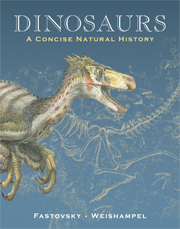Book contents
- Frontmatter
- Contents
- Why a natural history of dinosaurs?
- Dedication
- Part I Reaching back in time
- Part II Ornithischia: armored, horned, and duck-billed dinosaurs
- Part III Saurischia: meat, might, and magnitude
- Part IV Endothermy, endemism, and extinction
- 12 Dinosaur thermoregulation: some like it hot
- 13 The flowering of the Mesozoic
- 14 A history of paleontology through ideas
- 15 The Cretaceous–Tertiary extinction: the frill is gone
- Glossary
- Figure credits
- Index of subjects
- Index of genera
15 - The Cretaceous–Tertiary extinction: the frill is gone
- Frontmatter
- Contents
- Why a natural history of dinosaurs?
- Dedication
- Part I Reaching back in time
- Part II Ornithischia: armored, horned, and duck-billed dinosaurs
- Part III Saurischia: meat, might, and magnitude
- Part IV Endothermy, endemism, and extinction
- 12 Dinosaur thermoregulation: some like it hot
- 13 The flowering of the Mesozoic
- 14 A history of paleontology through ideas
- 15 The Cretaceous–Tertiary extinction: the frill is gone
- Glossary
- Figure credits
- Index of subjects
- Index of genera
Summary
Chapter objectives
Learn about the K/T boundary
Learn about the K/T extinction
Evaluate scientific hypotheses in light of incomplete data
How important were the deaths of a few dinosaurs?
The extinction to which the non-avian dinosaurs finally succumbed after about 163 million years on Earth is called the Cretaceous–Tertiary extinction, commonly abbreviated K/T. The K/T extinction involved much more than just dinosaurs. Among the “highlights” were:
a large asteroid collided with Earth;
the great cycles of nutrients that formed the complex food webs in the world's oceans temporarily shut down;
many mammals went extinct;
landscapes were deforested; and
wild fires raged.
By comparison with that, how important were the deaths of a few dinosaurs?
Geological record of the latest Cretaceous
Earth gets a makeover
Mountains and volcanoes. The Late Cretaceous was a time of active plate movement, mountain-building, and volcanism. The Rocky Mountains, Andes, and Alps were all entering important growth periods.
India experienced a unique episode of volcanism that occurred between 65 and 60 Ma (from the very end of the Cretaceous into the Early Tertiary), consisting of episodes of lava flows, called the Deccan Traps, which spewed molten rock over an area of 500,000 km2. Volatile gasses – carbon dioxide, sulfur oxides, methane, and possibly nitric oxides among the most prevalent – were emitted into the atmosphere, possibly affecting global temperatures and damaging the ozone layer.
- Type
- Chapter
- Information
- DinosaursA Concise Natural History, pp. 320 - 344Publisher: Cambridge University PressPrint publication year: 2009

